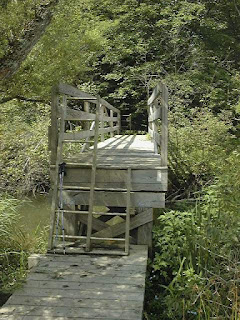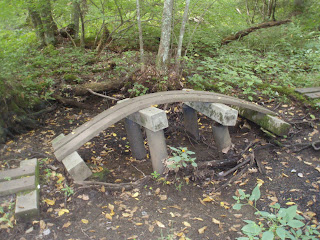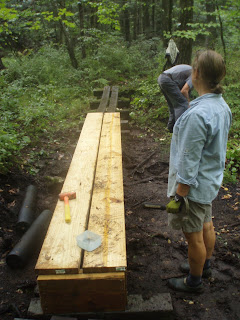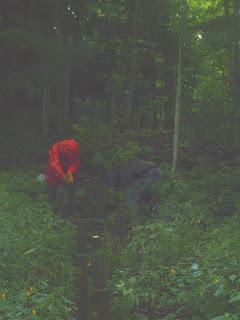Saturday September 8, 2012
Bridge and bog bridges south of Shays Rebellion.
On Saturday morning (leading into a very rainy afternoon) Don, Dave and Cosmo met to start replacing and re-building bog bridges in the "Mosquito Coast" area of the Housatonic Valley. We were joined at lunchtime by Jim and Christine in from other events in the area. Christine is the maintainer for this section of the AT.
This long, flat section of the AT links the Riga Plateau and Jug End in the southern Taconics to East Mountain and the southern end of the Berkshires that the AT rides north to Vermont.
The AT crosses the valley on land purchased for the Trail by the National Park Service in the 1980's as part of the effort to get the AT off of roads and onto permanently protected lands. Some of the land here is in active agriculture, while other sections are more marginal--you could call it a swamp. To get hikers through these low, wet areas, a network of bog bridges, board walks and bridges stitches the trail together between farm land, low hills and abandoned fields.
The wet, swampy land is a perfect habitat for winged insects, always on the lookout for fresh mammalian blood to provide a shot of protein to produce their next generation. This can come as a bit of a shock to hikers used to the breezy ridges of the surrounding mountains.
We set this project on the schedule near the end of the summer, hoping to miss the worst of the swarms. This year's minor drought helped keep the population down as well.
 |
| Hubbard Brook Bridge |
When the AT first went off of the local roads, one of the major obstacles was crossing Hubbard Brook and it's associated wetlands. The AT Committee built a major span and extensive boardwalk over the brook when the land was first acquired, and as the Trail continued south into the woods, installed approximately 30 sections of bog bridge over low spots and minor drainages between the brook and Rt 41 (Undermountain Rd).
Now, some 20 years later, some rehabilitation and fix up is needed. At the time, the Committee used a new material, 'plastic lumber'. In those days before Trex became common on decks and patios, this material looked like a good choice for installation in areas where native timbers would quickly rot and require frequent replacement. This material has survived well, but is slippery when wet and so flexible that it sags considerably between supports.
 |
| The Hobbit Bridge (note path worn by hikers alongside it) |
Our mission today was to shore up some of the most saggy parts, install some new sections where muddy areas persist and (regretfully) replace the "Hobbit Bridge", a construction that makes excellent use of the floppy qualities of the planks, but is so slippery that hikers bypass it in favor of the muddy stream bank. We've replaced it with a considerably less charming 12ft long box bridge made from pressure treated 2x10's. It will last a long time in the shady swamp and be a bit less challenging to cross.
 |
| Christine and Don complete the framing on the replacement bridge |
 |
| The completed (boring) bridge |
There is no intent to make the AT completely safe. That would be impossible--and depends a lot on what one considered 'safe' to be. Statistically, hikers (and volunteers) are in more danger driving to the worksite or trailhead than they are working or hiking. However, when hikers 'vote with their feet' and bypass a trail structure in such a way that damages the surrounding environment or widens the footpath, trail clubs must take measures to prevent or reduce impacts from trail visitors--hence, sadly, the demise of the Hobbit Bridge.
 |
| Don (invisible in his dark raingear) and Dave relocate an existing bog bridge |
 |
| Rot-resistant Tamarack for new bog bridges awaits |
In other work this rainy afternoon, we carried in the remaining bog bridge materials and began work on rehabilitating the sagging existing ones. We'll have another visit to the area on Sept 29th to finish this project.



.jpg)


.jpg)
.jpg)
.jpg)













